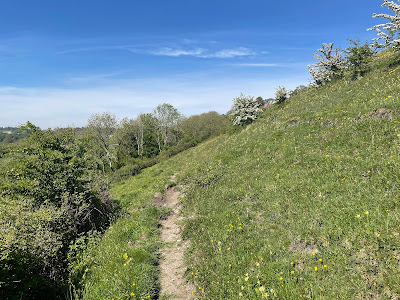We have started to develop an interest in looking at gardens, inspired by recent visits to the Sir Harold Hillier Gardens and Malverlys. We found Keyneston Mill on a list of the best gardens in Dorset. Its website tells us that "Keyneston Mill is the creative home of
Parterre Fragrances. Here you can explore the Scented Botanic Gardens
and surrounding 50-acre working estate, where we grow, harvest and
distil unusual plants and ingredients for our luxury perfumes."
After parking the first thing you see is the Long Barn, a combined shop and tea room, with loads of the beautiful cistus flowers above to catch your eye.
There is no sign of an actual Mill, but the gardens are set out in three main areas. The first is the Padua Garden, inspired by the Orto Botanico in Padua, the first academic botanical garden in Italy. It contains plants from the Floral Perfume family, such as roses, nicotiana, stocks, many of which are scented.
This gives way to the Fougere (Fern, from French) Garden.
Beyond that lies the Spice Garden, which contains ingredients associated with oriental perfumes. We loved these massive angelica plants.
At the end of this sequence there is the Geodome and Cocktail Garden. Sadly it was not open!
To the right there are perfume crops fields, while to the left lies the River Stour. We have an affection for the Stour as we did the Stour Valley Way some years ago. (A delightful walk, but we didn't see all that much of the river.)
Here and by the nearby river meadow there were loads of Dragonflies, in particular the dark blue Beautiful Demoiselles.
We enjoyed our visit and wish Parterre Perfumes every success.
Conditions: warm and sunny.
Map: Explorer 118 (Shaftesbury and Cranfield Chase).






























